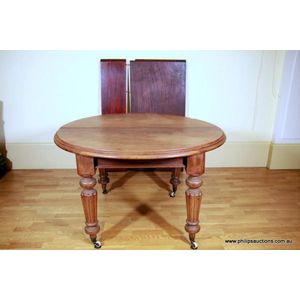Sheraton Revival Mahogany Occasional Table
You must be a subscriber, and be logged in to view price and dealer details.
Subscribe Now to view actual auction price for this item
When you subscribe, you have the option of setting the currency in which to display prices to $Au, $US, $NZ or Stg.
- Skirt - In furniture, the skirt is a strip of wood underneath the top or front of the item. On chairs, the skirt is the support under the seat joining the legs, while on tables, the skirt is the support under the top, that assists in supporting the top and also joins the legs. On carcase furniture such as chests and cabinets, the skirt is the timber strip immediately under the drawers or cupboard.
- Mahogany - Mahogany is a dense, close grained red-coloured timber from the West Indies and Central America. It was first imported into Europe in the the early 18th century and its use continued through the 19th century. It was popular for furniture making because of its strength, the wide boards available, the distinctive grain on some boards, termed flame mahogany and the rich warm colour of the timber when it was polished.. The "flame" was produced where a limb grew out from the trunk of the tree, and this timber was usually sliced into veneers for feature panels on doors, backs and cornices.
Some terms used to describe mahogany relate to the country from which it originally came, such as "Cuban" mahogany, "Honduras" mahogany etc. However unless the wood has been tested the names assigned are more a selling feature, rather than a true indication of the timber's origin. - Thomas Sheraton - Thomas Sheraton (1751-1806) was born in Stockton on Tees in the north of England. He was apprenticed to a local cabinetmaker and after working as a cabinetmaker, Sheraton moved to London about 1790. Although he described himself as a cabinet-maker, like Chippendale, no definite piece of furniture can be traced to him as maker. Nevertheless, he was immensely influential and in 1791-4 published his four volume book 'The Cabinet-Maker and Upholsterer's Drawing Book'. The books were used as source of design by the furniture-making trade , who often simplified or modified the designs to suit their own preferences. Sheraton furniture is marked by restraint and sophistication, elegance and discretion, though he also found time to invent fanciful combination furniture.
- Stringing - Fine inlaid lines, in contrasting colour to the carcase timber, found mainly on furniture made in the styles of the later 18th and early 19th centuries. Stringing, which may be of satinwood, pine, ebony, horn, brass or occasionally ivory, is found principally on drawer fronts, around the outer edges of usually tapered legs and French bracket feet, around the edges of inlaid panels and between the joint of the cross banding and carcase timber on table tops, chests of drawers, cabinets etc. The effect is to emphasize the line of the piece and add to the impression of lightness and elegance. Stringing also occurs in Sheraton-revival-style furniture of the later 19th and early 20th centuries.
- Circa - A Latin term meaning 'about', often used in the antique trade to give an approximate date for the piece, usually considered to be five years on either side of the circa year. Thus, circa 1900 means the piece was made about 1900, probably between 1895 and 1905. The expression is sometimes abbreviated to c.1900.
This item has been included into following indexes:
Visually similar items

A French walnut and marquetry decorated oval two tier side table. 78 cm high, 41 cm wide, 31 cm deep.

A French Louis XV style oval shaped marble top two tier occasional table. 74 cm high, 54 cm wide, 36 cm deep

A small Edwardian mahogany occasional table, early 1900s, the circular table with cross banded edges, satinwood and ebony stringing, a small undertier below supported on a quartet of gently curved stretchers, and raised on slender and tapering square secti

A Victorian cedar extension dining table, second half 19th century; with two leaves, the circular table with thumb nail and bullnose edging above a skirt and block form capitals to turned and ribbed tapering legs terminating in toupie feet with brass caps
